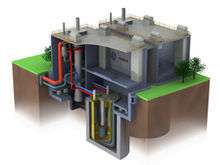PRISM (reactor)

PRISM (Power Reactor Innovative Small Module, sometimes S-PRISM from SuperPRISM) is the name of a nuclear power plant design by GE Hitachi Nuclear Energy (GEH).
The S-PRISM represents GEH's Generation IV reactor solution to closing the nuclear fuel cycle and is also part of its Advanced Recycling Center (ARC) proposition[1] to U.S. Congress to deal with nuclear waste.[2] S-PRISM is a commercial implementation of the Integral Fast Reactor developed by Argonne National Laboratory between 1984 and 1994.
It is a sodium-cooled fast breeder reactor, based on the Experimental Breeder Reactor II (EBR-II) design, scaled up by a factor of ten.[3]
The design utilizes reactor modules, each having a power output of 311 MWe, to enable factory fabrication at low cost.
In an identical fashion to the EBR-II that it is based on, the reactor would transition to a much lower power level whenever temperatures rise significantly, moreover the reactor vessel modules are pool type, as opposed to loop type, with the pool conferring substantial thermal inertia and the final key safety feature includes a "RVACS", which is a passive reactor vessel air cooling system to remove decay heat. These safety systems are passive and therefore always operate and are to prevent core damage when no other means of heat removal are available.[4]
Integral fast reactor
The integral fast reactor was developed at the West Campus of the Argonne National Laboratory in Idaho Falls, Idaho and was the intended successor to the Experimental Breeder Reactor II, which achieved first criticality in 1965 and ran for 30 years. The Integral Fast Reactor project was shut down by the U.S. Congress in 1994.
Possible US demonstration reactor
In October 2010, GEH signed a memorandum of understanding with the operators of the Department of Energy's Savannah River site, which should allow the construction of a demonstration reactor prior to the design receiving full NRC licensing approval.[5]
UK interest in PRISM
In October 2011, The Independent reported that the UK Nuclear Decommissioning Authority (NDA) and senior advisers within the Department of Energy and Climate Change (DECC) had asked for technical and financial details of the PRISM, partly as a means of reducing the country's plutonium stockpile.[6] In July 2012, GEH submitted a feasibility report to the NDA showing that the PRISM could provide a cost-effective way of quickly dealing with the UK's plutonium stockpile. The feasibility report includes an assessment from the consultancy firm DBD Limited suggesting there are "no fundamental impediment(s)" to the licensing of the PRISM in the UK. [7] [8] A 2012 Guardian article pointed out that a new generation of fast reactors such as the PRISM "could dispose of the waste problem, reducing the threat of radiation and nuclear proliferation, and at the same time generate vast amounts of low-carbon energy". David J. C. MacKay, chief scientist at the DECC, was quoted as saying that British plutonium contains enough energy to run the country's electricity grid for 500 years.[9]
See also
References
- ↑ Testimony to U.S. Congress
- ↑ GE Energy press release. June 18, 2009
- ↑ Stuart Nathan (13 May 2013). "Prism project: A proposal for the UK's problem plutonium". The Engineer. Retrieved 29 November 2013.
- ↑ "Technical Report: Summary of advanced LMR (Liquid Metal Reactor) evaluations: PRISM (Power Reactor Inherently Safe Module) and SAFR (Sodium Advanced Fast Reactor). DOI: 10.2172/5491968".
- ↑ "Prototype Prism proposed for Savannah River". World Nuclear News. 2010-10-28. Retrieved 2010-11-04.
- ↑ Connor, Steve (2011-10-28). "New life for old idea that could dissolve our nuclear waste". The Independent. London. Retrieved 2011-10-30.
- ↑ Clark, Duncan (2012-07-09). "Nuclear waste-burning reactor moves a step closer to reality". The Guardian. London. Retrieved 2012-07-12.
- ↑ "World's first nuclear waste-burning PRISM reactor moves a step closer in the UK". Mark Lynas. 2012-07-09. Retrieved 2012-07-12.
- ↑ Pearce, Fred (2012-07-30). "Are fast-breeder reactors the answer to our nuclear waste nightmare?". The Guardian. London.
External links
- GE Hitachi: GE Hitachi PRISM | The Future of Nuclear Energy
- World Nuclear Association: Fast Neutron Reactors
- Esquire Magazine: "Meet the Man Who Could End Global Warming"
- PRISM IFR (drawing)
- S-PRISM Fuel Cycle Study,Proceedings of ICAPP ’03
- The Guardian article: Nuclear waste-burning reactor moves a step closer to reality
- The Independent: UK Government's radical plan to ‘burn up’ UK’s mountain of plutonium